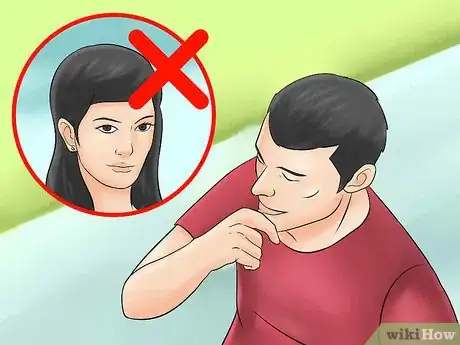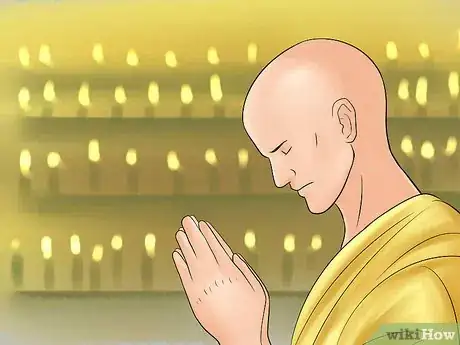This article was co-authored by wikiHow Staff. Our trained team of editors and researchers validate articles for accuracy and comprehensiveness. wikiHow's Content Management Team carefully monitors the work from our editorial staff to ensure that each article is backed by trusted research and meets our high quality standards.
There are 8 references cited in this article, which can be found at the bottom of the page.
wikiHow marks an article as reader-approved once it receives enough positive feedback. In this case, 84% of readers who voted found the article helpful, earning it our reader-approved status.
This article has been viewed 455,438 times.
Learn more...
A monk is a person who withdraws from society to concentrate on religious service. Several major religions have monastic traditions, the most notable being Christian and Buddhist. Becoming a monk involves study, devotion, and years of training and transitioning. Monastic life is a simple, dedicated life of servitude, which asks the devoted to live a celibate lifestyle and relinquish worldly goods.
Steps
Preparing for a Monastic Life
-
1Devote yourself to religion. Being a monk means living in spiritual, physical, and philosophical devotion to your faith. Begin your journey to monkhood by making a deep commitment to your spiritual path today. Begin studying daily, and engaging in prayer several time a day. Strive to embody your faith in every aspect of your life.[1]
-
2Research different monastic orders. Although the basic routine of a monk may be much the same in any order, there are also important differences to consider.
- Monks in contemplative orders spend most of their time inside the walls of the monastery praying, while those in active orders leave the monastery to serve others. Some active orders assign monks to work far from a monastery.
- In communal orders, the monks spend time with their fellow monks, working, praying and eating together. In eremitic orders, monks are discouraged from interacting with each other and spend most of each day in their cells.
- Monastic orders are typically started by important religious figures who devote themselves to maintaining the traditions and working on the causes established by the founder.
Advertisement -
3Commit to a life of celibacy. Regardless of the religion or order, nearly every monastic community practices celibacy. Begin walking the path monkhood by taking a personal vow of celibacy. This practice will allow you to gauge if this is a realistic and practical goal for you. Having committed successfully to celibacy will also show the depth of your devotion when you approach a monastery to join.[2]
-
4Practice communal living. Another aspect of most monastic orders is living in close community with others. This means sharing meals, sharing quarters, and in some cases sharing all worldly belonging with one another. You can begin testing out this lifestyle by joining a communal living situation. Look for community houses in your area with open rooms.[3]
-
5Let go of your worldly possessions. Along with living in communion with others, monks across religious orders relinquish their ownership of material possessions. In some cases, monks donate everything they own to the church. You can get a taste of this life and move closer to monkhood but giving away some of what you own and living a simpler life.[4]
Becoming a Christian Monk
-
1Visit a monastery. If you are interested in becoming a monk, your first step is to visit a monastery. For the most part, monasteries are open to visits from potential devotees. Some will allow you to stay for a few days at a time. On these visits, you will learn about the daily routine at the monastery, as well as what is expected of the monks.[5]
- Some monasteries offer guesthouse accommodations to outsiders who agree to follow certain rules, such as observing curfews and periods of silence.
- You may want to consider a monastic retreat, in which you will take part in the daily routine of the monastery.
-
2Become a novice. After you have visited a monastery and decided that you’d like to devote yourself to this life, you can express your interest in becoming a novice, and move into the monastery. This is practice, sometimes called an “observership,” is your first step toward becoming a Christian monk. As a novice, you will be taught every aspect of the monkhood. Meanwhile, the monks will observe you to decide if your personality is suitable for monastic life.
- Depending on the order, there may be more than one level of novicehood.
- This process can take up to one year, again depending on the order.
-
3Become a postulate. After you have passed your novicehood, you may be asked to become a postulate, or intended monk. At this stage, you may be given more responsibility at the monastery. Likewise, the expectations set for you will be higher. This stage provides a deeper experience by which you will decide that this vocation is right for you, as well as to prove yourself to the other monks.[6]
-
4Take temporary vows. As a postulate, you will be asked to take “temporary vows,” committing you to the lifestyle and beliefs of monastic life, for as long as you remain within the monastery. These vows will vary depending on the specific order, however they will almost certainly involve a deep devotion to God, a celibate disposition, and the rejection of material belongings.
-
5Make your final commitment to monastic life. After your time as a postulate, you will eventually be invited to join the monastery for good. You will be ordained as a Christian monk, and you will take permanent monastic vows.[7]
Becoming a Buddhist Monk
-
1Learn Buddhist teachings. Before you can approach a teacher with the intention of becoming a monk, you must be quite learned in the Buddhist tradition, well read in Buddhist teachings, and well versed in Buddhist thought. Begin your journey to monkhood by devoting yourself to the study of Buddhism.[8]
-
2Find a teacher. This step will be difficult if you are not already involved with practicing Buddhists, but in order to become a monk, you will need a teacher who can give you permission to be ordained. Seek out Buddhist temples in your area, or travel to a part of the world where Buddhism is more prevalent. Stay open in your heart and allow it to lead to you the teacher you seek.[9]
- You may try writing letters or emails to Buddhist teachers in your area and opening a correspondence.
-
3Establish a meditation practice. A crucial component of the Buddhist monastic tradition is a deep and dedicated meditation practice. Some Buddhist orders actually value a strong mediation practice above knowledge of Buddhist teachings. Being able to demonstrate your own practice may be essential to showing that you belong within the monkhood.
-
4Spend time in a monastery. After you have sufficiently educated yourself, and found a teacher to take this education further, you must locate a monastery and spend some time there. If you are good fit, you be welcomed to take your “lay vows,” or the vows of Buddhist devotion and intention made by a lay person. By spending time in a Buddhist monastery, you will be able to make certain that this is the life for you.[10]
-
5Take your lifelong vows. After spending some time in the monastic community, you may be invited to stay. You will be asked to take the lifelong vows of a Buddhist monk and you will be ordained as such. You will be asked to commit to a celibate lifestyle and relinquish your material goods.[11]
-
6Stay for five years. When one is ordained to be a Buddhist monk, one traditionally stays with that monastery for five years. Becoming a Buddhist monk means joining a religious community: the Sangha. The purpose of this community is to study and practice the teachings of Buddha, as well as to share them with others. As a Buddhist monk, you will strengthen the bonds of the Sangha over your five (or more) years with that group.[12]
Community Q&A
-
QuestionWhat's with the swastika under "Becoming a Buddhist Monk"?
 Community AnswerEastern religions had been using the swastika sign for thousands of years before the Nazis perverted its meaning. In Buddhism, it means "All is well."
Community AnswerEastern religions had been using the swastika sign for thousands of years before the Nazis perverted its meaning. In Buddhism, it means "All is well." -
QuestionWill I ever be able to see my family again?
 Community AnswerIn most monastic orders, the answer is yes. Your family can visit you.
Community AnswerIn most monastic orders, the answer is yes. Your family can visit you. -
QuestionCan one be a Jewish monk?
 Carolyn BarrattCommunity AnswerThere are not that many known monastic groups in the Jewish religion today. Two thousand years ago, there was a monastic Jewish community known as the Essenes. However, they do not exist anymore.
Carolyn BarrattCommunity AnswerThere are not that many known monastic groups in the Jewish religion today. Two thousand years ago, there was a monastic Jewish community known as the Essenes. However, they do not exist anymore.
References
- ↑ http://en.dhammadana.org/sangha/monks/become.htm
- ↑ http://fpmt.org/centers/sangha/firstletter/
- ↑ http://imisangha.org/ordain/preparing-to-become-a-buddhist-monk-or-nun
- ↑ http://www.buddhanet.net/e-learning/buddhistworld/layguide.htm
- ↑ http://mepkinabbey.org/wordpress/becoming-a-monk/
- ↑ http://mepkinabbey.org/wordpress/becoming-a-monk/
- ↑ http://www.religious-vocation.com/differences_religious_orders.html#.Vwz43hMrJ-V
- ↑ http://imisangha.org/ordain/preparing-to-become-a-buddhist-monk-or-nun
- ↑ http://fpmt.org/centers/sangha/firstletter/
About This Article
To become a monk, make a deep commitment to your spiritual path, take a personal vow of celibacy, and dedicate yourself to a simpler life by giving away some of possessions. Since monks usually live in close quarters together, consider testing out this lifestyle by joining a communal living situation in your area. Then, research some of the major monastic orders, like the Christian and Buddhist traditions, to discover which path you want to pursue. For specific tips on joining different monastic traditions, read on!














































































